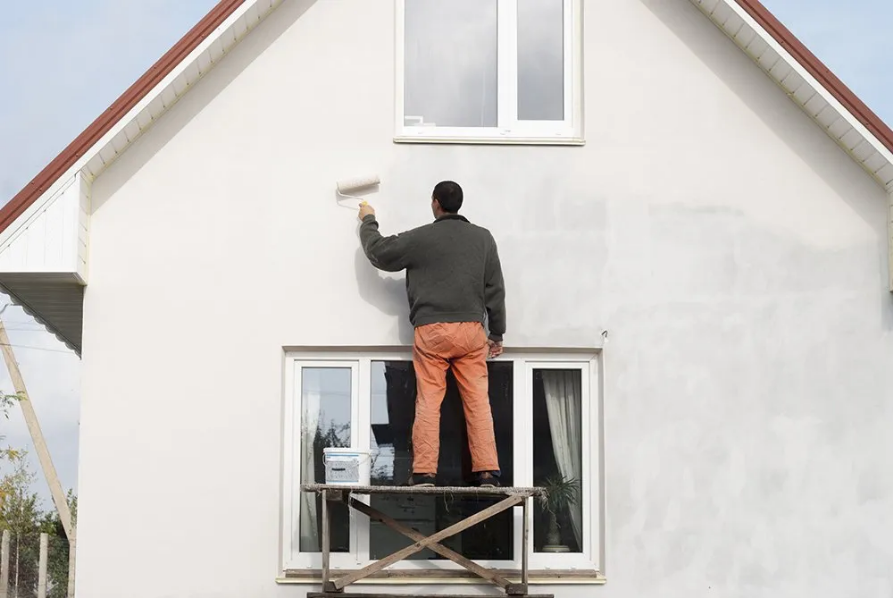Depending on the type of material used for your home’s siding, you may only have to paint your house every 10, 15, or even 20 years. That’s a long time to live with your paint color choices, so you want to get your home’s exterior right. A designer can help you make the decision, and home improvement professionals and homeowners alike have benefited from home design specialists. However, you can make it on your own fairly easily if you know what you want and understand a bit about color theory.
Whether you have a traditional home with a traditional exterior, victorian, craftsman, tudor, modern, or you have a red brick exterior, front porch or a garage and garage doors – whatever you have to work with can be made into something great and carry you for years to come with an exterior makeover.
Don’t forget your doors, as having a new door color like a yellow door, olive green front door, or a red door can make such a big difference, and if you’re doing a remodel, you can also consider changing the style of the door.
1. Nice and Neutral
Neutral colors are those colors that don’t belong to any specific color group like blue, red, or yellow. Neutral colors can include white (bright white, off-white), cream, beige, taupe, gray, greige and brown. While neutral colors can be light or dark, they are often universal, meaning they can go with any color in the rainbow, and allow some interesting accent color possibilities.
You should choose neutral colors for the exterior of your home if you want your home to look clean, simple, and classy. Neutral colors are also a great idea if you want to make other areas of your home stand out, such as your landscaping or entryway. Neutral colors also go with many different shades of roof shingles and gutter colors. Some examples of an exterior neutral palette include dove grey with white trim or beige with ivory trim and neutral front door colors.
2. Classic and Timeless
Classic and timeless colors are those combinations that stand the test of time, like black and white, navy and white, or white and yellow. White and gray may fall into this category as well as the above category.
The allure of choosing classic house colors for the exterior of your home is that the colors will never go out of style. What’s more, they will give your home clean, crisp lines that will make it look stately, classy, and put together.
3. Vivid and Complementary
If you’re not afraid of color, or if you really want your house to stand out, you may want to think about choosing a vivid, complementary color palette. Choosing complementary colors involves choosing two colors from opposite sides of the color wheel. You can use this strategy to select a two-toned color scheme or a scheme of three colors. The latter is called a split-complementary color scheme.
Examples of two-toned complementary color combinations include red and aqua, green and magenta, and blue and yellow. If you prefer even more color, you can choose a split-complementary scheme. Examples of a split-complementary color scheme include yellow, yellow-orange, and blue; jade, magenta, and orange; or red, dark green, and light green. Don’t be afraid to experiment with color combinations!
4. Clean and Monochromatic
Monochromatic color schemes involve using colors of the same hue (i.e. red, blue, yellow) but of different intensities, brightness or levels of darkness (sometimes thought of as undertones). For example, a golden-yellow house with a pale lemon trim color would be considered monochromatic.
Choosing a monochromatic color scheme is easy because most single-color paint swatches portray a single hue in various levels of intensity. If you choose a color from the lighter portion of the swatch and one from the darker portion of the swatch, you will have a complimentary monochromatic color scheme.
If you’re still having trouble figuring out what you want, pick up some color swatches. Some are organized into color schemes, which will give you an idea of what colors go well together. This will help you visualize your options. Many of the major brands will have color combos to look at, including Behr, Valspar, Benjamin Moore, Sherwin-Williams and others.
When you have your choices narrowed down, pick up a few samples and paint small sections on your home to figure out which colors look best. Make sure you allow the paint to dry thoroughly, as this can affect how the color looks. Once you have made your choices, or if you need help making those choices, contact Elite Painting KC to get your exterior painting project started.


